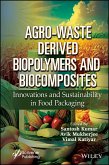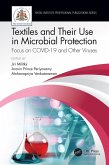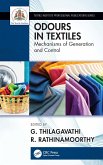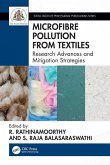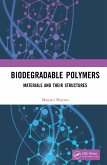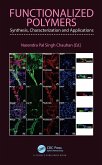Tanvi Vats (India Gautam Buddha University), Shubhanshi Sharma (India Gautam Buddha Uni)
Plastic Bottles
Processing, Recycling, Regulations and Alternatives
Tanvi Vats (India Gautam Buddha University), Shubhanshi Sharma (India Gautam Buddha Uni)
Plastic Bottles
Processing, Recycling, Regulations and Alternatives
- Gebundenes Buch
- Merkliste
- Auf die Merkliste
- Bewerten Bewerten
- Teilen
- Produkt teilen
- Produkterinnerung
- Produkterinnerung
Plastic Bottles: Processing, Recycling, Regulations and Alternatives, explores the lifecycle of plastic bottles, from creation to disposal, offering a comprehensive and accessible look at bottle packaging.
Andere Kunden interessierten sich auch für
![Multiplicative Analytic Geometry Multiplicative Analytic Geometry]() Svetlin G. GeorgievMultiplicative Analytic Geometry106,99 €
Svetlin G. GeorgievMultiplicative Analytic Geometry106,99 €![Agro-Waste Derived Biopolymers and Biocomposites Agro-Waste Derived Biopolymers and Biocomposites]() Agro-Waste Derived Biopolymers and Biocomposites219,99 €
Agro-Waste Derived Biopolymers and Biocomposites219,99 €![Textiles and Their Use in Microbial Protection Textiles and Their Use in Microbial Protection]() Textiles and Their Use in Microbial Protection117,99 €
Textiles and Their Use in Microbial Protection117,99 €![Odour in Textiles Odour in Textiles]() Odour in Textiles119,99 €
Odour in Textiles119,99 €![Microfibre Pollution from Textiles Microfibre Pollution from Textiles]() Microfibre Pollution from Textiles113,99 €
Microfibre Pollution from Textiles113,99 €![Biodegradable Polymers Biodegradable Polymers]() Manjari SharmaBiodegradable Polymers145,99 €
Manjari SharmaBiodegradable Polymers145,99 €![Functionalized Polymers Functionalized Polymers]() Functionalized Polymers103,99 €
Functionalized Polymers103,99 €-
-
-
Plastic Bottles: Processing, Recycling, Regulations and Alternatives, explores the lifecycle of plastic bottles, from creation to disposal, offering a comprehensive and accessible look at bottle packaging.
Hinweis: Dieser Artikel kann nur an eine deutsche Lieferadresse ausgeliefert werden.
Hinweis: Dieser Artikel kann nur an eine deutsche Lieferadresse ausgeliefert werden.
Produktdetails
- Produktdetails
- Verlag: Taylor & Francis Ltd
- Seitenzahl: 96
- Erscheinungstermin: 10. Februar 2025
- Englisch
- Abmessung: 225mm x 145mm x 12mm
- Gewicht: 240g
- ISBN-13: 9781032890845
- ISBN-10: 1032890843
- Artikelnr.: 72174779
- Herstellerkennzeichnung
- Libri GmbH
- Europaallee 1
- 36244 Bad Hersfeld
- gpsr@libri.de
- Verlag: Taylor & Francis Ltd
- Seitenzahl: 96
- Erscheinungstermin: 10. Februar 2025
- Englisch
- Abmessung: 225mm x 145mm x 12mm
- Gewicht: 240g
- ISBN-13: 9781032890845
- ISBN-10: 1032890843
- Artikelnr.: 72174779
- Herstellerkennzeichnung
- Libri GmbH
- Europaallee 1
- 36244 Bad Hersfeld
- gpsr@libri.de
Dr. Tanvi Vats completed her PhD in chemistry jointly from GGS Indraprastha University and National Physical University, New Delhi. She currently serves Gautam Buddha University, Greater Noida as a faculty member where she teaches BTech, BSc and MSc students. Her research interests include nanomaterials and science-related aspects of Intellectual Property Rights. She has attended various national and international conferences and has several research papers, book chapters, encyclopedia articles, and popular science articles to her credit. She has co-authored two books, Microwave assisted Polymerization (published with RSC, Cambridge, UK) and Comprehensive Chemistry: Theory And Practice (published with Viva Books Private Limited, New Delhi). She is a life-time member of the Association of Environmental Analytical Chemistry of India (AEACI), Analytical Chemistry Division Bhabha Atomic Research Centre, Trombay, Mumbai, and the "Academy of Microscope Science & Technology", DMSRDE, Kanpur, India. Shubhanshi Sharma is an aspiring researcher in the field of polymer packaging. She has completed her MSc in Applied Chemistry from Gautam Buddha University, Greater Noida, India. It was during her Master's thesis on Bioengineering and biopolymers used for tissue engineering and regenerative medicine that she developed an interest in polymer packaging and also an aptitude in the area of science communication. She has a popular science article entitled "Packaging Food: Looking for Durable & Efficient Options" published in Science Reporter. During her leisure hours she finds great enjoyment in delving into books and documentaries that explore the rich tapestry of Indian history. Additionally, she finds solace in mountains and frequently go trekking with friends and family.
Part 1: Plastic Bottles: A necessary Evil?
Chapter 1.1Introduction- The Omnipresent Plastic Bottle
Chapter 1.2 Composition: Materials used
Chapter 1.3 Labels/ identification codes for different types of plastics
Chapter 1.4 Manufacturing Processes
Part 2: Plastic Bottles and the Planet
Chapter 2.1 Limitation of plastic bottles in packaging
Chapter 2.2 Environmental impact of plastic bottles production and disposal
Chapter 2.3 Recycling challenges
Chapter 2.4 Advancements in recycling challenges
Chapter 2.5 Recycling through various case studies
Part 3: Biopolymers: An Emerging Alternative
Chapter 3.1 Potential application of biopolymers in packaging of bottles
Chapter 3.2 Types of biopolymers in bottle packaging
Chapter 3.3 Advantages of biopolymers applications in bottle packaging
Chapter 3.4 Limitations of biopolymer usage
Part 4: Regulatory Framework and Policies
Chapter 4.1 Global regulations on plastic bottle production and disposal
Chapter 4.2 Efficacy of implementing Extended Producer Responsibility (EPR)
Chapter 4.3 Legislations regarding biopolymers as bottle packaging
Part 5: Future Scope and Possibilities
Chapter 5.1 Sustainable alternatives
Chapter 5.2 Issues to be addressed in advanced R&D in plastic bottle
recycling technologies
Chapter 1.1Introduction- The Omnipresent Plastic Bottle
Chapter 1.2 Composition: Materials used
Chapter 1.3 Labels/ identification codes for different types of plastics
Chapter 1.4 Manufacturing Processes
Part 2: Plastic Bottles and the Planet
Chapter 2.1 Limitation of plastic bottles in packaging
Chapter 2.2 Environmental impact of plastic bottles production and disposal
Chapter 2.3 Recycling challenges
Chapter 2.4 Advancements in recycling challenges
Chapter 2.5 Recycling through various case studies
Part 3: Biopolymers: An Emerging Alternative
Chapter 3.1 Potential application of biopolymers in packaging of bottles
Chapter 3.2 Types of biopolymers in bottle packaging
Chapter 3.3 Advantages of biopolymers applications in bottle packaging
Chapter 3.4 Limitations of biopolymer usage
Part 4: Regulatory Framework and Policies
Chapter 4.1 Global regulations on plastic bottle production and disposal
Chapter 4.2 Efficacy of implementing Extended Producer Responsibility (EPR)
Chapter 4.3 Legislations regarding biopolymers as bottle packaging
Part 5: Future Scope and Possibilities
Chapter 5.1 Sustainable alternatives
Chapter 5.2 Issues to be addressed in advanced R&D in plastic bottle
recycling technologies
Part 1: Plastic Bottles: A necessary Evil?
Chapter 1.1Introduction- The Omnipresent Plastic Bottle
Chapter 1.2 Composition: Materials used
Chapter 1.3 Labels/ identification codes for different types of plastics
Chapter 1.4 Manufacturing Processes
Part 2: Plastic Bottles and the Planet
Chapter 2.1 Limitation of plastic bottles in packaging
Chapter 2.2 Environmental impact of plastic bottles production and disposal
Chapter 2.3 Recycling challenges
Chapter 2.4 Advancements in recycling challenges
Chapter 2.5 Recycling through various case studies
Part 3: Biopolymers: An Emerging Alternative
Chapter 3.1 Potential application of biopolymers in packaging of bottles
Chapter 3.2 Types of biopolymers in bottle packaging
Chapter 3.3 Advantages of biopolymers applications in bottle packaging
Chapter 3.4 Limitations of biopolymer usage
Part 4: Regulatory Framework and Policies
Chapter 4.1 Global regulations on plastic bottle production and disposal
Chapter 4.2 Efficacy of implementing Extended Producer Responsibility (EPR)
Chapter 4.3 Legislations regarding biopolymers as bottle packaging
Part 5: Future Scope and Possibilities
Chapter 5.1 Sustainable alternatives
Chapter 5.2 Issues to be addressed in advanced R&D in plastic bottle
recycling technologies
Chapter 1.1Introduction- The Omnipresent Plastic Bottle
Chapter 1.2 Composition: Materials used
Chapter 1.3 Labels/ identification codes for different types of plastics
Chapter 1.4 Manufacturing Processes
Part 2: Plastic Bottles and the Planet
Chapter 2.1 Limitation of plastic bottles in packaging
Chapter 2.2 Environmental impact of plastic bottles production and disposal
Chapter 2.3 Recycling challenges
Chapter 2.4 Advancements in recycling challenges
Chapter 2.5 Recycling through various case studies
Part 3: Biopolymers: An Emerging Alternative
Chapter 3.1 Potential application of biopolymers in packaging of bottles
Chapter 3.2 Types of biopolymers in bottle packaging
Chapter 3.3 Advantages of biopolymers applications in bottle packaging
Chapter 3.4 Limitations of biopolymer usage
Part 4: Regulatory Framework and Policies
Chapter 4.1 Global regulations on plastic bottle production and disposal
Chapter 4.2 Efficacy of implementing Extended Producer Responsibility (EPR)
Chapter 4.3 Legislations regarding biopolymers as bottle packaging
Part 5: Future Scope and Possibilities
Chapter 5.1 Sustainable alternatives
Chapter 5.2 Issues to be addressed in advanced R&D in plastic bottle
recycling technologies



